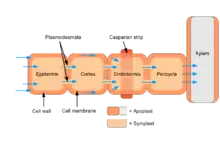Casparian strip
In plant anatomy, the Casparian strip (named after Robert Caspary) is a band of cell wall material deposited in the radial and transverse walls of the endodermis, and is chemically different from the rest of the cell wall - the cell wall being made of lignin[1] and without suberin - whereas the Casparian strip is made of suberin and sometimes lignin .[2]
.jpg.webp)

The chemistry of the Casparian strip has been described as composed of suberin. According to some studies,[3] the Casparian strip begins as a localized deposition of phenolic and unsaturated fatty substances in the middle lamella between the radial walls, as partly oxidized films. The primary wall becomes encrusted with and later thickened by deposits of similar substances on the inside of that wall. The encrustation of the cell wall by the material constituting the Casparian strip presumably plugs the pores that would have otherwise allowed the movement of water and nutrients via capillary action along that path.[4] The cytoplasm of the endodermal cell is firmly attached to the Casparian strip so that it does not readily separate from the strip when the cells are subjected to contraction of the protoplasts. At the root, the Casparian strip is embedded within the cell wall of endodermal cells in the non-growing region of the root behind the root tip.[5] Here, the Casparian strip serves as a boundary layer separating the apoplast of the cortex from the apoplast of the vascular tissue thereby blocking diffusion of material between the two.[6] This separation forces water and solutes to pass through the plasma membrane via a symplastic route in order to cross the endodermis layer.[5]
Casparian strips differentiate after an outward growth of the cortex is completed. At this level of the root development, the primary xylem of its vascular cylinder is only partly advanced. In gymnosperms and angiosperms displaying secondary growth, the roots commonly develop only endodermis with Casparian strips. In many of those, the endodermis is later discarded, together with the cortex, when the periderm develops from the pericycle. If the pericycle is superficial and the cortex is retained, either the endodermis is stretched or crushed or it keeps pace with the expansion of the vascular cylinder by radial anticlinal divisions, and the new walls develop Casparian strips in continuity with the old ones.[7]
In the absence of secondary growth (most monocotyledons and a few eudicots), the endodermis commonly undergoes wall modifications. There are two developmental stages beyond the development of the Casparian strip. In the second stage suberin (or endoderm[4]) coats the entire wall on the inside of the cell. As a result, the Casparian strip is separated from the cytoplasm and the connection between the two ceases to be evident. In the third stage, a thick cellulose layer is deposited over the suberin, sometimes mainly on the inner tangential walls. The thickened wall, as well as the original wall in which the Casparian strip is located, may become lignified, creating a secondary cell wall. The Casparian strip may be identifiable after the thickening of the endodermal wall has occurred. The thickened endodermal wall may have pits. The successive development of endodermal walls is clearly expressed in monocotyledons.[8][9]
See also
References
- Naseer, S.; Lee, Y.; Lapierre, C.; Franke, R.; Nawrath, C.; Geldner, N. (2012). "Casparian strip diffusion barrier in Arabidopsis is made of a lignin polymer without suberin". Proceedings of the National Academy of Sciences. 109 (25): 10101–6. Bibcode:2012PNAS..10910101N. doi:10.1073/pnas.1205726109. PMC 3382560. PMID 22665765.
- Raven, Biology of Plants, p 656, 8th Ed
- Van Fleet, D. S. (1961). "Histochemistry and function of the endodermis". Botanical Review. 27 (2): 165–220. doi:10.1007/BF02860082. S2CID 45393531.
- Frey-Wyssling, A.; H. H. Bosshard (1959). Cytology of the Ray Cells in Sapwood and Heartwood. Cram.
- Taiz, L., Zeiger, Eduardo, Møller, Ian Max, & Murphy, Angus. (2015). Plant physiology and development (Sixth ed.).</
- Grebe, M (2011). "Unveiling the Casparian strip". Nature. 473 (7347): 294–5. doi:10.1038/473294a. PMID 21593860. S2CID 873056.
- von Guttenberg, H. (1943). Die physiologischen Scheiden. Borntraeger.
- OGURA, Y. (1938). "Problems in morphology (13)". Botany and Zoology. 6: 139–148.
- Napp-Zinn, A. F. (1953). 100 Jahre Köln-düsseldorfer Rheindampfschiffahrt: Insbesondere Zerstörung und Wiederaufbau 1939-1953. Köln-Düsseldorfer Rheindampfshiffahrt.
- Esau, Katherine (1965). Plant Anatomy. John Wiley & Sons. p. 767.